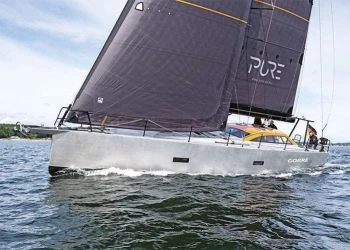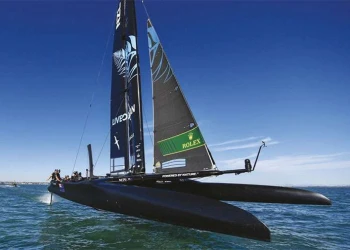
A new high speed cruiser from Baltic to look out for this summer
A new high speed cruiser from Baltic to look out for this summer
Here’s a first glimpse of a yacht to look out for this summer… a high-speed cruiser designed and built to participate in major Mediterranean regattas
There’s a new generation of not-quite-80ft monohulls on the water, 24m LOA being a watershed for various reasons, and a fair few more new builds of that size are in the pipeline. One of the most interesting (and quite likely one of the fastest) is a full custom Baltic 80 with an impressive power-to-weight ratio.
Commissioned by an experienced yachtsman – his first build with Baltic Yachts – the 23.99-metre Baltic 80 Custom is conceived as a high-speed offshore cruiser with the ability to win Mediterranean regattas. It’s a fiercely competitive circuit but she certainly has the design and build pedigree to be a strong contender.
Performance cruising with ability to race what this boat is all about,’ says Baltic project manager Lars Gripenberg. The sleek, powerful hull makes those intentions clear with its low freeboard, chamfered reverse bow and a minimal coachroof styled by Jens Paulus. Distinctive and purposeful with a striking paint job in a colour described as old rosé offset by a jet black rig and details, she is sure to turn heads under sail and in harbour.
Design and construction
She’s a full custom project with naval architecture by judel/vrolijk. With a ballast ratio of more than 35 per cent plus a powerful hull shape that confers high form stability when slightly heeled, and SA:D (sail area : displacement ratio) of 41.5, her vital statistics tick all the theoretical boxes for exceptional sailing performance.
‘Initially the concept was developed by extensive CFD and rating studies with a strong focus on racing performance,’ Rolf Vrolijk explains. ‘With the involvement of the actual customer, cruising and living features gained more importance.
‘We decided to keep the wide hull lines generating high stability for both purposes, powerful racing and comfortable cruising. The deck freeboard was pushed as low as possible to just suit the interior demands – a sleek look and an improved vertical centre of gravity.’
Her composite construction is state of the art. The hull and structural bulkheads are Sprint carbon/epoxy laminates with Corecell foam core and prepreg carbon reinforcement in high-load areas. The deck is prepreg carbon with Nomex core and foam-cored prepreg where it’s needed. The entire structure weighs just 6.5 tons.
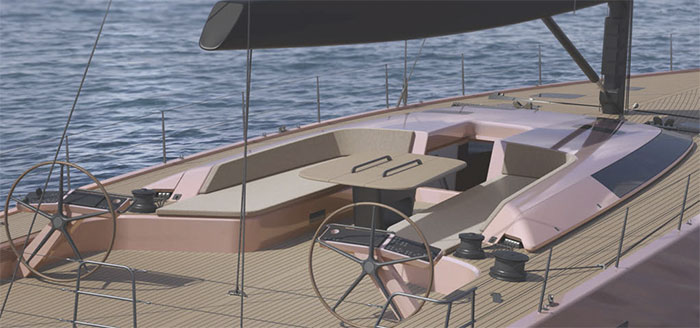
She has twin rudders and a lifting keel from APM with a lead bulb and steel fin, housed in a solid prepreg carbon trunk that extends up to the deck to give a draught of 5.3m under sail, reducing to 3.5m in harbour.
‘We were able to reduce the weight of the yacht – with all interior and living comfort expected – to 36 tons in light ship conditions,’ Vrolijk says.
On deck
‘Space is a very important consideration on this boat,’ Gripenberg explains. ‘The sail store is really big for an 80-footer.’ A large hatch in the flush foredeck gives access to a capacious sail locker that occupies prime real estate down below – on a typical cruiser-racer most of that space would be part of the owner’s suite.
The deck plan is impressively clean. There’s a track for a self-tacking cruising headsail and a removable pair of transverse tracks further aft for the racing genoa. The pushpit, stanchions and pop-up mooring cleats are all titanium, primarily to save weight but also to reduce maintenance.
The anchoring system is neat and simple with a snug recess in the bowsprit to hold the anchor securely while the yacht is under way, ready to deploy immediately when needed. ‘From a user point of view it’s the best solution, Gripenberg says. ‘It’s mostly out of sight but easy to use, nothing is hidden, no rotating parts and no secrets under water.’ There’s also a retractable hydraulic mooring winch on the foredeck for warping operations in harbour.
The vast, open cockpit creates a lot of open-air living space, while also being a well-judged dual purpose layout for cruising and racing. It’s designed with equal emphasis on easy handling by a crew of two and efficient operation by a full racing crew, who are likely to be a mix of professional and skilled amateur sailors. ‘The yacht offers enough winches for all headsail trimming and peel sets,’ Vrolijk says.
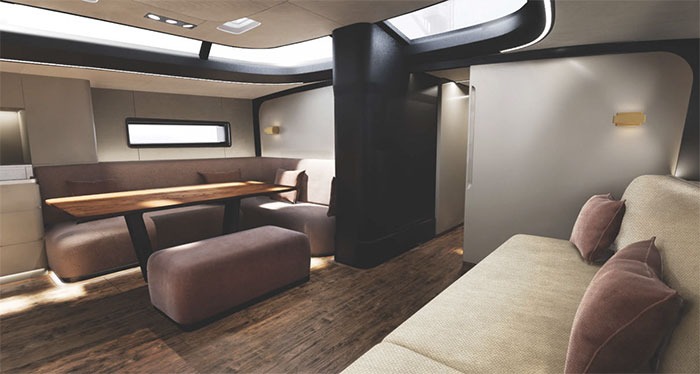
The mainsheet is on a six-ton captive reel winch below the deck next to the mast - and all other lines – sheets, halyards and runners – are controlled by four hydraulic Harken winches, two on each side of the cockpit just forward of the helm pedestals, with jammers for all the lines led aft from the mast. Large stowage bins for sheet and halyard tails, set in the aft ends of the coaming with top-hinged hatch lids, are an elegant and practical solution to avoid the usual snakes’ wedding of lines under foot on the cockpit sole.
In cruising mode there’s a simple and effective bimini on poles for shade. A big sprayhood deploys from a slim, U-shaped hatch in the coachroof and connects with the bimini to shelter the cockpit, which can be fully enclosed on three sides in foul weather.
Rig and sails
‘The sailplan is a double setup for cruising and racing,’ Gripenberg says. ‘The mast and furling boom are from Hall Spars, with carbon standing rigging.’ The foretriangle is large, with a hydraulic under-deck furler for racing as well as cruising headsails. There is a rotating padeye in the 1.9m long bowsprit for code sails of 55 per cent and 75 per cent girth, with sail area up to 445m². A 695m² gennaker is tacked to a fixed padeye on the end of the bowsprit and flown with a manual furler. The sail wardrobe is from North Sails and she has complete, separate sail packages for racing and cruising. ‘In close cooperation with yard, owner’s team and sailmaker, we achieved a versatile sailplan for both modes of use,’ Vrolijk says. ‘For cruising we reduced the upwind sail area by 10 per cent compared with the racing setup with a J1.5. The overall sail area is kept high with 409m² upwind.’
Down below
From the general arrangement it’s clear that this is a boat designed for private use, configured without any concessions for charter operation. The accommodation, for six guests in three cabins with a further cabin for two crew, is laid out to give much better than average weight distribution within the hull, which will have a positive impact on motion comfort at sea as well as boatspeed. ‘This layout would also work very well for a family sailing the boat without any crew, some friends on board and a lot of living space,’ Gripenberg says.
Instead of a huge, full-beam master suite in the forward half of the hull, the owner’s cabin is aft on the starboard side. It still has ample space, a big double bed and a nice en suite bathroom – and it’s a more practical, comfortable location than the forepeak for a cabin that will be used when the yacht is under way, especially when sailing offshore.
There are two guest cabins forward of the mast, a large double and a smaller cabin with two single bunks. They share a large bathroom in the forepeak, which also serves as the main day heads on board. The saloon has a dining area to port with L-shaped seating around a table and a smaller seating unit on the centreline. To starboard there is a deeper sofa for relaxation and an aft-facing nav station with a large chart table. The galley, on the port-hand side, is notably spacious and open plan with the saloon.
The crew cabin, in the yacht’s port aft quarter, is designed to accommodate a couple and it is just as large as the double guest cabin up forward, with its own private en suite bathroom.
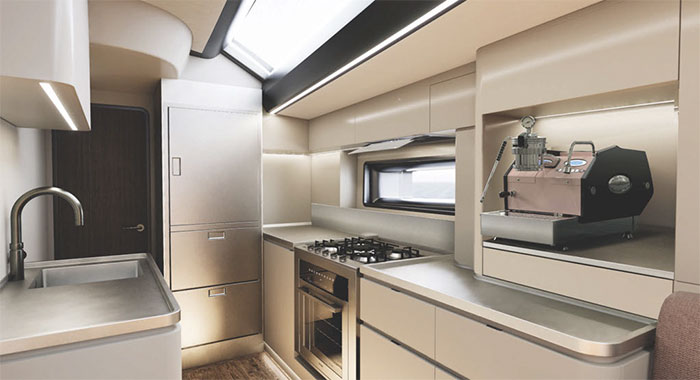
The interior styling is a collaboration between two designers, Jens Paulus and Axel Vervoordt. The first thing you notice is that there’s a lot less wood than usual in the finish. ‘We have it only on the cabin doors and the floorboards,’ Gripenberg says. ‘Most other surfaces are either painted or covered in fabric. The owner did not want it to look like an apartment, he wanted something different.’ The carbon keel trunk is a prominent feature and there are lots of carbon details – raw carbon, showcasing the quality of the yacht’s laminate structure.
Efficient systems
Smart choices have been made to ensure high levels of reliability and efficient operation. It’s all controlled by Baltic Yachts’ own in-house developed PLC. Most systems run off a 48V bank of Mastervolt lithium batteries and there’s a separate 24V service battery. In typical operating conditions there should be ample capacity to run the air conditioning all night long without needing to use the generator.
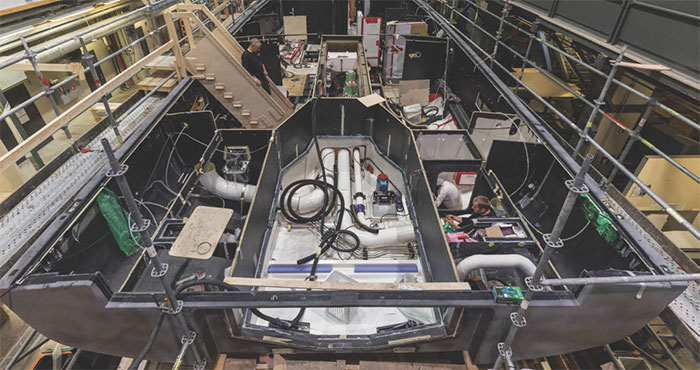
The propulsion setup is conventional with a 172kW Cummins diesel, ZF gearbox, shaft drive and folding propeller. In addition to the main Fischer Panda generator, a second 48V DC alternator is connected to the engine specifically for battery charging while the yacht is motoring. ‘You usually want to charge the batteries first thing in the morning so you run the generator. Then you can switch it off and continue charging from the engine while the yacht is motoring,’ Gripenberg explains. It’s also possible to fast-charge by running the generator and engine at the same time.
One final nice feature for cruising is the generously sized stern garage, which accommodates a fully inflated 3.95m jet RIB tender.
The Baltic 80 Custom is due to launch in early summer and might be seen cruising in northern Europe before heading down towards the Mediterranean. It’s likely that she’ll make her regatta début there in due course – and we await the first racing results with interest.





